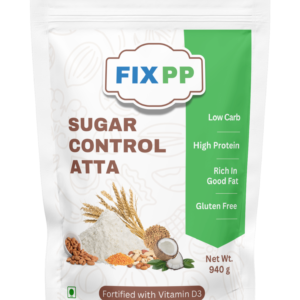Carbohydrates play a central role in diabetes management because they have the most significant impact on blood sugar levels. Understanding how to manage carbohydrate intake is key for people with diabetes, especially in the context of traditional Indian diets, which are typically high in carbs.
Role of Carbohydrates in Diabetes Management
- Impact on Blood Sugar Levels:
- When consumed, carbohydrates are broken down into glucose, which enters the bloodstream and raises blood sugar levels.
- The body’s insulin response regulates blood sugar by allowing cells to use glucose for energy. In diabetes, this process is impaired, leading to elevated blood sugar levels.
- Managing carbohydrate intake helps control post-meal blood glucose spikes and maintain overall glycemic control.
- Types of Carbohydrates:
- Simple Carbohydrates: Found in sugar, sweets, and refined foods. They are quickly absorbed and cause rapid spikes in blood glucose levels.
- Complex Carbohydrates: Found in whole grains, legumes, and vegetables. They are absorbed more slowly, providing sustained energy and a more gradual impact on blood sugar levels.
- Glycemic Index (GI) and Glycemic Load (GL):
- Glycemic Index measures how quickly a carbohydrate-containing food raises blood glucose levels. Low-GI foods (GI < 55) are preferable for diabetics as they cause slower and smaller blood sugar spikes.
- Glycemic Load considers both the GI and the amount of carbohydrates in a serving, providing a more practical impact of food on blood glucose levels.
Managing Carbohydrates in Indian Meals
1. Choosing the Right Carbohydrates:
- Opt for whole grains like brown rice, millets (bajra, ragi), and quinoa instead of refined grains like white rice, wheat flour and white flour (maida).
- Include legumes and pulses such as lentils (dal), chickpeas (chana), kidney beans (rajma), and black-eyed peas (lobia), which are high in fiber and have a lower GI.
- Prefer non-starchy vegetables like spinach, broccoli, cauliflower, and gourds (lauki, tori) which are low in carbs but high in nutrients.
2. Portion Control and Meal Timing:
- Limit portion sizes of high-carb foods to control overall intake. For example, restrict rice to a small bowl (1/2 cup cooked) and fill the plate with vegetables and protein sources.
- Spread carbohydrate intake evenly throughout the day to avoid large spikes in blood sugar.
3. Smart Swaps in Indian Cuisine:
- Rice: Replace white rice with brown rice, quinoa, or mix rice with a high-fiber grain like barley or bulgur.
- Chapati/Paratha: Use multigrain flour, and consider adding fiber-rich ingredients like oat, flaxseed, chia seeds, to the dough.
FIX PP Sugar Control Atta is formulated to meet the needs of a diabetes-friendly diet. Its unique blend of flaxseed, groundnut seed, chia seed, and other superfoods ensures a low glycemic load (GL) and a balanced nutritional profile, making it the optimal choice for individuals seeking effective blood sugar control.
- Snacks: Choose roasted chana, nuts, and seeds over high-carb snacks like samosas, biscuits, or fried namkeen.
4. Incorporating Fiber-Rich Foods:
- Fiber slows down the digestion and absorption of carbohydrates, helping to stabilize blood sugar levels. Include vegetables, whole grains, and legumes in every meal.
- Examples: Add extra vegetables to dal, sabzi, or curry; use leafy greens in rotis (methi roti) or parathas.
Examples of Carbohydrate Management in Indian Meals
- Breakfast Options:
- Poha: Use brown rice poha and add vegetables like peas, carrots, and capsicum to increase fiber.
- Upma: Use whole-grain rava or replace it with quinoa or broken wheat (daliya) for a lower GI option.
- Oats: Make savory oats with vegetables, or a vegetable omelet with oats flour.
- Lunch/Dinner Options:
- Rice-Based Meals: Choose smaller portions of brown rice or mix it with quinoa, and pair it with a high-protein dal or paneer curry.
- Roti-Based Meals: Opt for smaller-sized rotis made with multigrain flour; pair with vegetable sabzi, a bowl of dal, and a small serving of curd.
- Snack Options:
- Chaat: Replace fried papdi with roasted chana, and load up on veggies like tomatoes, onions, and coriander.
- Bhel Puri: Use puffed brown rice or roasted makhana (fox nuts) with lots of raw vegetables.
- Desserts:
- For occasional treats, use natural sweeteners like stevia or limit portions strictly. Consider lower-GI options like fruit salads (with portion control), or sweets made with almond flour.
Key Takeaways
- Choose Low-GI, High-Fiber Foods: Focus on whole grains, legumes, and non-starchy vegetables.
- Control Portions: Even healthier carbs need portion control to avoid blood sugar spikes.
- Balance Meals: Include protein and healthy fats in each meal to slow down carbohydrate absorption.
- Regular Monitoring: Adjust carbohydrate intake based on blood sugar readings to fine-tune meal plans.
By implementing these strategies, individuals can better manage their carbohydrate intake, leading to more stable blood sugar levels and improved overall diabetes management while still enjoying traditional Indian meals.


Recent Comments